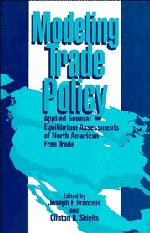Book contents
- Frontmatter
- Contents
- List of Contributors
- Dedication
- Part I Introduction
- Part II Multisector Models
- Part III Sector-Focused Models
- 6 Agriculture in the Mexico-U.S. Free Trade Agreement: A General Equilibrium Analysis
- 7 Wage Changes in a U.S.-Mexico Free Trade Area: Migration Versus Stolper-Samuelson Effects
- 8 The Auto Industry and the North American Free Trade Agreement
- 9 Trade Liberalization in Quota-Restricted Items: The United States and Mexico in Textiles and Steel
- Part IV Dynamic Models
- Index
9 - Trade Liberalization in Quota-Restricted Items: The United States and Mexico in Textiles and Steel
Published online by Cambridge University Press: 25 March 2010
- Frontmatter
- Contents
- List of Contributors
- Dedication
- Part I Introduction
- Part II Multisector Models
- Part III Sector-Focused Models
- 6 Agriculture in the Mexico-U.S. Free Trade Agreement: A General Equilibrium Analysis
- 7 Wage Changes in a U.S.-Mexico Free Trade Area: Migration Versus Stolper-Samuelson Effects
- 8 The Auto Industry and the North American Free Trade Agreement
- 9 Trade Liberalization in Quota-Restricted Items: The United States and Mexico in Textiles and Steel
- Part IV Dynamic Models
- Index
Summary
Introduction
This paper uses numerical general equilibrium modeling to analyze the possible consequences of bilateral free trade between the United States and Mexico in two key sectors – textiles and steel. These sectors are especially important to possible bilateral negotiations because of the voluntary export restraints (VERs) and other barriers that restrict bilateral trade. Changes in these arrangements will likely be one of the more central Mexican bilateral negotiating demands, certainly as far as trade in manufactures are concerned. Because of the quotas involved, however, such liberalization must also be seen in the context of the wider system of global trade restraints in these sectors involving third countries, a theme our paper emphasizes.
Our model results clearly show that liberalization in both of these sectors is jointly advantageous for the United States and Mexico, with the specifics of the liberalization package important for the configuration of gains. These effects are not that large, but Mexico is the larger gainer, reflecting both the much smaller size of Mexico's economy relative to the United States' and the more significant U.S. barriers in these sectors. Our results also suggest that liberalization will have adverse effects on third countries. Gains to the United States not only reflect conventional trade liberalization gains on the production and consumption side but also reflect reduced rent transfers to quota-restricted third countries due to lowered domestic United States market prices from bilateral liberalization with Mexico.
- Type
- Chapter
- Information
- Modeling Trade PolicyApplied General Equilibrium Assessments of North American Free Trade, pp. 256 - 298Publisher: Cambridge University PressPrint publication year: 1994
- 2
- Cited by



